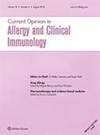Allergen immunotherapy and eosinophilic esophagitis: friends or foes?
IF 2.6
4区 医学
Q2 ALLERGY
Current Opinion in Allergy and Clinical Immunology
Pub Date : 2024-09-16
DOI:10.1097/aci.0000000000001029
引用次数: 0
Abstract
PURPOSE OF REVIEW The connection between eosinophilic esophagitis (EoE) and food and airborne allergens is complex. Exposure to allergens (mainly food) is often the trigger for EoE flares. The development of EoE has been described as a side effect of allergen immunotherapy, especially oral immunotherapy (OIT, with food allergens), while isolated cases of EoE have been reported during sublingual immunotherapy (SLIT, with extracts of aeroallergens). RECENT FINDINGS EoE is currently recognized as a common side effect of OIT, while a solid correlation between SLIT and EoE is missing. Animal models have been developed to study the pathophysiological link between sensitization to aeroallergens and the induction of EoE and will probably provide an interpretation of why there are cases of EoE developed during SLIT. Recent findings in animal models suggest a genetic connection to EoE development after sensitization and re-exposure to airborne allergens. Subcutaneous allergen immunotherapy does not have a causative effect on EoE; on the contrary, a beneficial effect on EoE has been reported. Moreover, epicutaneous immunotherapy with a vector containing milk has also been used to treat children with milk-induced EoE. SUMMARY Discovering the immune links between allergens and EoE will further guide the proper use of allergen immunotherapy and help define future strategies for the management of EoE.过敏原免疫疗法和嗜酸性粒细胞食管炎:是敌还是友?
综述目的 嗜酸性粒细胞食管炎(EoE)与食物和空气中的过敏原之间的关系非常复杂。接触过敏原(主要是食物)往往是嗜酸性食管炎发作的诱因。据描述,EoE 的发生是过敏原免疫疗法的副作用之一,尤其是口服免疫疗法(OIT,使用食物过敏原),而舌下免疫疗法(SLIT,使用航空过敏原提取物)期间也有个别 EoE 病例的报道。目前已开发出动物模型来研究对空气过敏原的致敏与诱发呃逆之间的病理生理学联系,这或许能解释为什么在 SLIT 期间会出现呃逆病例。最近在动物模型中的研究结果表明,致敏和再次暴露于空气传播的过敏原后出现的咽喉炎与遗传有关。皮下过敏原免疫疗法不会对咽喉炎产生致病作用,相反,有报道称这种疗法对咽喉炎有益。此外,使用含有牛奶的载体进行皮外免疫疗法也被用于治疗牛奶诱发的儿童咽喉炎。摘要发现过敏原与咽喉炎之间的免疫联系将进一步指导过敏原免疫疗法的正确使用,并有助于确定未来的咽喉炎治疗策略。
本文章由计算机程序翻译,如有差异,请以英文原文为准。
求助全文
约1分钟内获得全文
求助全文
来源期刊
CiteScore
5.90
自引率
3.60%
发文量
109
审稿时长
6-12 weeks
期刊介绍:
This reader-friendly, bimonthly resource provides a powerful, broad-based perspective on the most important advances from throughout the world literature. Featuring renowned guest editors and focusing exclusively on one to three topics, every issue of Current Opinion in Allergy and Clinical Immunology delivers unvarnished, expert assessments of developments from the previous year. Insightful editorials and on-the-mark invited reviews cover key subjects such as upper airway disease; mechanisms of allergy and adult asthma; paediatric asthma and development of atopy; food and drug allergies; and immunotherapy.

 求助内容:
求助内容: 应助结果提醒方式:
应助结果提醒方式:


